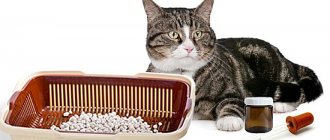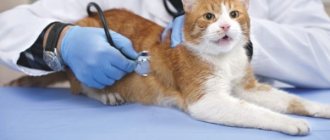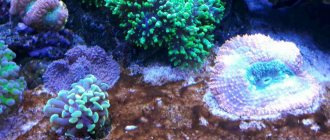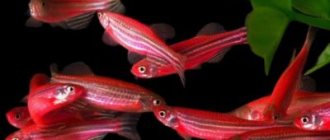To make an accurate diagnosis of a sick cat, it is not enough for a doctor to have high professional skills. Examining the animal, based on external symptoms - poor condition of the coat, watery eyes, fever, etc., he can only say that the cat is unwell.
However, the external signs of many cat diseases are similar, so it is only possible to determine what exactly a pet is sick with through laboratory tests. The more complex the disease, the less common it is, the more tests specialists working in the laboratory will have to do.
One of the main studies that helps establish the diagnosis of the disease is a general urine test. When carrying out a standard analysis, the physical properties of the liquid, its chemical composition and microscopy of the resulting urine sediment are assessed.
Physical indicators
Quantity
In cats, almost 70% of all liquid consumed is excreted in urine. The daily dose of urine in a cat will depend on the following aspects: the functioning of the genitourinary system, the functioning of the sweat glands, the composition of the feed, as well as the functioning of the kidneys and gastrointestinal tract. Normally, an adult cat produces 20-30 milliliters of urine in 24 hours.
An experienced veterinarian will be able to detect the presence of certain diseases based on the volume of urine.
Color
The color of urine can determine not only the presence of pathologies, but also what the cat eats and what medications it takes. The normal color of urine is yellow and all shades of yellow.
Specific gravity
It shows how much solids are dissolved in the urine. The indicator can vary greatly during the day, as it depends on the functioning of individual organs, as well as on food.
In cats, the average specific gravity is 1.020 1.035 grams/l. If the indicator is slightly too high, this may indicate dehydration of the cat’s body. If the density is significantly lower than normal, this indicates the development of renal failure or other pathologies.
Analysis result
Precipitation, transparency
If sediment or visible flakes are found in the cat’s urine, then most likely there are inflammatory processes in the body. With laboratory analysis, specialists will be able to identify the source of these sediments.
Urine in the room should be completely clear. To check its transparency, you can pour it into a narrow flask, and attach a magazine or newspaper to the other side. If you can read the text, then everything is fine with the clarity of your pet’s urine.
Smell
The normal smell of urine in furry cats is specific and not strong. The smell may differ from the norm, and this mainly happens for the following reasons:
- Rot. If your pet's urine smells rotten, then most likely there are several areas of rot in the urinary tract. In this case, you should immediately contact a veterinarian.
- Acetone. Many cat owners know that if the urine has a strong smell of acetone, it means the cat has diabetes. In rare cases, the symptom may indicate another pathology - ketosis.
- Ether. This smell indicates that your pet has become infected with roundworms. The diagnosis is not 100%, so it is necessary to undergo examination at a veterinary clinic.
- Ammonia. If after going to the toilet you smell ammonia from the litter box, then you need to urgently take the cat to the hospital. Since in 90% of cases such a symptom indicates inflammation of the bladder.
- Cal. The smell of feces can indicate only one pathology - paraproctitis.
Reaction
The reaction of urine is determined by acidity, the indicator is measured in pH units. The reaction in cats is considered slightly acidic, since they eat mainly meat products. In the morning this indicator will be very low, and maximum after eating.
The pH environment is also checked for various pathologies and during treatment, since in this way it is possible to monitor the treatment.
Consistency
Normally, urine in cats should be liquid, that is, it will flow like water from one container to another.
With pathologies associated with the kidneys, the consistency may become jelly-like or even jelly-like. If you find such abnormalities in your furry, you should immediately take him to see a veterinarian.
Urine color
PETERSBURG
A little about the analyzes
A veterinarian, like any doctor, is an ordinary person who has special knowledge, skills and abilities. There are no supernatural abilities - he has normal vision, not x-rays. Therefore, to make a correct diagnosis, he needs data from diagnostic studies.
One of the most common tests is a urine test. This type of analysis allows you to assess both the condition of the urinary system and the animal’s body as a whole.
Urine examination includes assessment of physical properties, chemical composition and sediment microscopy.
Physical properties These include color, quantity, transparency and specific gravity.
The amount of urine excreted per day in cats is determined in a hospital setting. The owner of the animal can only subjectively judge this indicator, unless the pet goes to the tray without filler, when it is possible to measure the volume by pouring the contents into a measuring cup. A healthy animal “drains” an amount of liquid that is approximately equal to the volume of water drunk per day.
Increased urine output is observed in diabetes, inflammatory processes, and chronic renal failure. Reduced diuresis is characteristic of shock and acute renal failure.
Color ranges from light yellow to yellow. The color largely depends on the type of food and the amount of water you drink during the day. With increased diuresis, the fluid is very light; with low diuresis, it is dark.
The coloring is affected by taking medications, as well as pathological conditions:
with hematuria, the urine will be reddish due to the admixture of blood; with increased secretion of bilirubin, it will be very dark, reminiscent of beer; with hemoglobinuria, a black color is observed, the presence of leukocytes will give a milky color.
An experienced doctor may suspect the presence of congestion, burns, vomiting or diarrhea by the dark color of urine. Too pale urine indicates diabetes.
Transparency. Normally, regular medium-sized typographic font can be easily read through liquid.
Turbidity appears when microbes are excreted in the urine - indicates the presence of inflammation in the kidneys; salts during the development of urolithiasis, leukocytes - the indicator indicates some kind of inflammation in the kidneys themselves, the bladder or in the ureters.
The urine reaction in cats, like carnivores, should be slightly acidic (less than 7, but not more than 6). The type of diet plays a significant role in the pH value: with purely meat it will be acidic, with vegetarian (if this is even possible) it will be alkaline.
A prolonged shift in one direction or another leads to urolithiasis due to the formation of uric acid or phosphate stones.
Important! It is better to check the reaction before sending it to the laboratory using a litmus strip (can be purchased at a pharmacy). The fact is that with prolonged standing, urine becomes alkalized and the indicator may be assessed incorrectly.
Acidic urine is characteristic of diabetic coma, renal failure, nephritis, kidney congestion. An alkaline reaction occurs with increased excretion of protein, leukocytes, and bacteria in the urine, when urea decomposes to ammonia.
Density or specific spring must be determined to assess the ability of the kidneys to concentrate urine. The norm for cats is 1.020-1.035.
A low indicator occurs with diabetes insipidus. A high density occurs with dehydration and acute glomerulonephritis. Sharp fluctuations from side to side indicate renal failure.
Urine chemistry
Protein. Normally, it should not be present, although a value of up to 0.3 g per liter is allowed. The appearance of protein in the urine indicates the presence of a pathogenic process, but which one is determined by additional research. So the protein can appear in biological fluid during infection, anemia, pyelonephritis, urolithiasis, cystitis, urethritis, pyometra.
Glucose is another indicator that is not detected in the urine of healthy animals. Most often, the appearance of this carbohydrate indicates diabetes. But it can also be released during stress or acute renal failure.
Physiological glucosuria occurs when there is an excessive intake of carbohydrates into the body, due to the administration of drugs (steroids, cardiac glycosides, adrenaline).
Ketone (acetone) bodies. Their detection in urine indicates ketonuria or acetonuria. Normally, this phenomenon should not be observed. The presence of ketone bodies indicates diabetes mellitus with the simultaneous detection of glucose, but if there is no glucose, then most likely the cause of the excretion of acetone in the urine is fasting, prolonged eating of fatty foods, diarrhea or vomiting, poisoning, fever.
Bilirubin is a bile pigment. Detection of it in the urine indicates problems with the liver, impaired outflow of bile due to blockage of the bile ducts, and the development of hemolytic jaundice.
Nitrite testing is not mandatory. This indicator is usually assessed when a bacterial infection is suspected. The fact is that microbes are able to convert nitrates, which are always present in urine, to nitrites.
Blood and hemoglobin in the urine are an alarm bell of a serious pathology. Pure blood is detected in cases of injury to the ureters or bladder during the passage of kidney stones, nephritis, and tumors in the organs of the urinary system.
Coffee staining indicates an admixture of hemoglobin, which occurs in cases of poisoning, burns, and some infections.
Sediment microscopy Examination of urine sediment will be most informative in samples obtained by puncture of the bladder. True, such manipulations are resorted to extremely rarely when absolutely necessary. Sediment microscopy includes the detection of epithelial cells, erythrocytes, leukocytes, and urinary casts. Using this method, it is possible to determine the “damaged zone” of the urinary system.
The epithelium in the sediment can be flat, transitional, or renal. Of interest to the clinician are the last two types; the presence of transitional is observed in cystitis, urethritis, malignant tumor of the bladder; renal epithelium is found in nephritis, poisoning, fever, infections, renal failure.
There should normally be no red blood cells in the sediment.
Leukocytes indicate inflammation in the kidneys, urethra and infectious processes. The type of leukocytes and sediment consistency helps determine the diagnosis:
with cystitis, the urine is cloudy, the reaction is usually alkaline, the sediment is viscous and viscous and consists of neutrophils; with nephritis, the biological fluid is acidic, the sediment is loose and consists of leukocyte casts; with glomerulonephritis, there are more lymphocytes in the sediment.
Urinary casts are formations consisting of protein, cells and salts. Normally there may be a single number of them. According to their structure, they are hyaline; they are found in cases of kidney disease, poisoning, and elevated body temperature; granular ones are formed during nephrosis and intoxication, waxy ones are an indicator of a severe course of the disease.
Microbes - they shouldn't exist. Appear in the urine as a result of contamination from the genital tract, passage through the lower part of the urethra, or in the pathology of pyelonephritis, urolithiasis, frequent catheterization, diabetes mellitus.
Salt crystals. The presence of salts in the urine does not always indicate a disease; they can appear when drugs are removed from the body, temperature or prolonged standing of biological fluid before it is examined. Therefore, when making a diagnosis of high salt content, these factors must be taken into account so as not to draw a false conclusion.
The following uric salts have diagnostic value; ammonium crystals are found in cystitis only in an alkaline reaction; oxalates occur in diabetes and severe infections or the formation of oxalate stones in the kidneys; phosphates appear when alkalization occurs during vomiting or frequent gastric lavage; uric acid is a sign of stone formation, but also may indicate pneumonia, lead poisoning, circulatory disorders, urate diathesis; the amount of urates increases when taking salicylates, phenylbutazone, chronic kidney failure; struvite is a sign of bladder disease, although it can appear in stagnant urine; calcium phosphate indicates arthritis, rheumatism, anemia.
Mucus is another pathological indicator that is not found in the urine of healthy cats. The appearance of mucous sediment indicates urethritis, prostatitis, cystitis, kidney stones, pyelitis (inflammation of the renal pelvis).
Chemical indicators
Glucose
Normally, glucose should not be present in the urine. But this sometimes happens, for example, if the cat is experiencing anxiety and stress or has diabetes.
Protein
Protein is not found in urine because it is formed during the process of cellular breakdown. If protein is found in the urine, then most likely this is a pathology; sometimes this happens due to severe hypothermia. Kidney failure, cystitis, inflammation of the bladder, pyelonephritis, cystitis, diabetes mellitus. All of the previously listed diseases can lead to protein entering the urine.
Ketone bodies
Ketone bodies are acetone, as well as some acids, which are actively produced by the pet’s body during fasting or stress. Determining the presence of ketone bodies is quite simple, since the urine will smell strongly of acetone.
Bile pigments
Urobilinogen and bilirubin are the main bile pigments and are produced by the liver. Based on their number, we can talk about how the liver functions. If the number of pigments increases sharply, this indicates that the body is being poisoned by toxins. Sometimes the level of pigments increases due to inflammation of the bile ducts.
Hemoglobin
In a healthy state, cats do not contain hemoglobin in their urine; it is formed only if the cat is severely intoxicated. They can occur due to the ingestion of poisons into the body (lead, arsenic, poison of insects and other animals). In such a situation, hemoglobin is formed during the breakdown of red blood cells, and then it ends up in the urine. The presence of hemoglobin can be detected by the dark brown color of the urine.
Red blood cells
When red blood cells enter urine, it acquires a reddish tint. This is considered a deviation because the urine should not contain red blood cells. In 70% of cases, the entry of red blood cells into the urine indicates injury to the urinary system.
Nitrites
If nitrites are present in the urine, it means your pet has caught an infection somewhere and it has entered the urinary tract. A detailed blood and urine test will help identify the infection that has entered your cat's body.
Additional symptoms of bilirubin in the urine of a cat to visit a veterinarian
In addition to detecting bilirubin in a cat’s urine, signs of liver dysfunction and bile outflow include:
- yellowing of the skin (noticeable on the inner surface of the ears, under the fur on the belly);
- yellowish tint of mucous membranes (eyes, near teeth);
- vomit;
- loss of appetite;
- increased thirst;
- dyspnea;
- the animal does not allow you to touch its belly;
- lethargy, low motor activity, lack of response to stimuli;
- darkening of urine;
- lightening of stool, sometimes diarrhea;
- elevated temperature (hot ears).
It is impossible to find their cause on your own, so if any of these symptoms appear, you need to be examined by a veterinarian. He usually prescribes an additional examination - ultrasound of the abdominal organs and biochemical blood test, blood and urine testing for infections (usually PCR - polymerase chain reaction for nucleic acids of hepatitis pathogens). If diagnosis is difficult, it may be necessary to perform a liver biopsy.
Crystalline precipitation
Sperm
During catheterization, a small amount of sperm may be released into the urine. There is no deviation in this; all this data can be seen on the overall final analysis table.
Epithelial cells
The urine may contain a small amount of flat cells; the content of other cells is already considered a deviation from the norm.
Test tubes
Fat
In general, there should be no fat in the urine, but if a drop of fat is found in the daily dose of urine, then this is not a pathology. But if there is much more fat, then this indicates a metabolic disorder in the pet. In this case, treatment at a veterinary clinic is required.
Leukocytes
At 400x magnification, 0 to 3 cells should be visible on the microscope. If there are more of them, then such a deviation is called leukocyturia, and if their number exceeds 50, then pyuria. This type of urine is dark brown in color and smells like pus.
Urinary cylinders
Normally, urinary casts should not be present in urine. If such a deviation is observed, this indicates that the urine is too alkaline. Therefore, it is able to flush out the urinary ducts.
Vitamin C
By the amount of vitamin C, you can determine how things are with vitamins in the cat’s body. A daily dose of urine contains approximately 50 mg of vitamin C.
Bacteria
If the cat is healthy, then the urine should be sterile. If bacteria are present, it means there is inflammation in the genitourinary system.
Slime
Mucus in urine is contained in small doses. Its amount can increase with inflammation in the body.
Mushrooms
Sometimes cats may have yeast in their urine when tested. They can enter the body along with anticancer drugs.
Analysis of urine
Cat urine analysis - features of the study
The truth has long been known that by correctly examining the urine of a four-legged patient, one can obtain a number of important information about the state of his health. By the way, the same principle underlies laboratory research on humans. After examining your cat's urine test, previously difficult issues regarding his health may be resolved.
- A complete laboratory test of a cat's urine includes:
- Density study.
- Color coefficient research.
- Definition of transparency.
- Determination of PH level.
After the above studies have been carried out, they begin to study the chemical indicators of urine . It is noteworthy that through a urine test, a veterinarian can determine the nature of your pet's diet. If you feed your cat an excess amount of meat, the pH of the urine will be acidic.
If a urine test reveals the presence of staphylococcus , then this is direct evidence of a kidney or urinary tract infection. For any infectious disease, veterinarians recommend passing urine for analysis .
In urine, the content of leukocytes, red blood cells, microbes, pathogens (for example, staphylococcus), epithelial cells and a large number of indicators are determined, which we will not list. Let’s just clarify that this type of laboratory test allows you to find out and/or confirm many diagnostic guesses.
What types of urine tests are used most often? Very often they do a general urine test of a cat , which shows the presence of leukocytes, red blood cells, sediment, color density and glucose in the urine. But in the most complex cases, a detailed analysis , which provides more extensive information.
How to collect urine for analysis?
Owners mainly use the following urine collection methods:
- Remove the litter from the tray and wash it with detergent. Wait until your pet comes to relieve itself, and then drain the urine into a sterile container.
- Sometimes cats are capricious and therefore refuse to go to the litter box without litter. In this case, you can put several paper napkins. When your cat goes to the toilet, squeeze out a small amount of urine into a container.
- If you are unable to take your cat’s urine for analysis, then contact a veterinary clinic. Experienced veterinarians will definitely be able to take a sample for research.
Try to have your urine analyzed at least once a quarter, as this way you can identify pathologies at the development stage.
How to take a urine test from a cat
Depending on the complexity and characteristics of the course of the disease, the animal’s urine is collected at home or in a veterinary hospital. If the material is collected at home, the cat owner should first wash the tray with running water without using chemicals and then pour boiling water over it. Then the urine can be poured into a sterile container (dry glass jar, special container for collecting tests) or drawn into a sterile syringe. If it is impossible to perform this manipulation at home, it is performed by a doctor using a catheter. Sometimes, if a cat has an obstruction in the urinary tract, it is necessary to perform cystocentesis (bladder puncture). Urine should be delivered to the laboratory for analysis no later than half an hour after collecting the material. If this condition cannot be met, the material must be cooled to +4°C. In this case, transportation can take up to 3 hours.
Interpretation of urine test results
The results of physical, chemical and microscopic studies are summarized in a table. Deciphering them makes it possible to get a general picture of the state of the animal’s body. Based on them, data from other tests and examinations, an experienced specialist makes a diagnosis and prescribes treatment.
Physical properties of urine
They are examined by organoleptic analysis. Its essence lies in assessing visual characteristics: color, smell, consistency, presence of visible impurities.
The following indicators are noted:
COL (color) - a yellow and light yellow tint of the liquid is considered normal.
CLA (transparency) - in healthy animals, the discharge is completely transparent.
Presence of sediment - may be present in small quantities. It is formed from insoluble salts, crystals, epithelial cells (kidneys, urethra, bladder, external genitalia), organic compounds, and microorganisms. A large amount of sediment is observed in cases of metabolic disorders and diseases.
Additionally, the presence of an uncharacteristic odor and a change in consistency may be noted.
The owner of the animal should pay attention to the nature of urination and the appearance of the discharge. If there is a change in color or smell, clots of mucus or pus, or blood particles appear when urinating, you should take your dog or cat to the veterinarian.
Chemical properties of urine
Examined using an analyzer. This method analyzes the composition of the isolated liquid for the presence and quantity of organic and chemical substances.
BIL (bilirubin) - normally in dogs this substance is contained in small undetectable quantities. In cats, this component is not present in its normal composition.
Dogs - missing (traces).
An increase in the indicator (bilirubinuria) may indicate liver disease, obstruction of the bile ducts, and disruption of hemolytic processes.
URO (urea) - is formed as a result of the breakdown of proteins.
Dogs - 3.5-9.2 mmol/l.
Cats - 5.4-12.1 mmol/l.
An increase in the indicator is evidence of renal failure, protein nutrition, acute hemolytic anemia.
A decrease in urea content may indicate insufficient protein intake, liver disease, and kidney disease.










